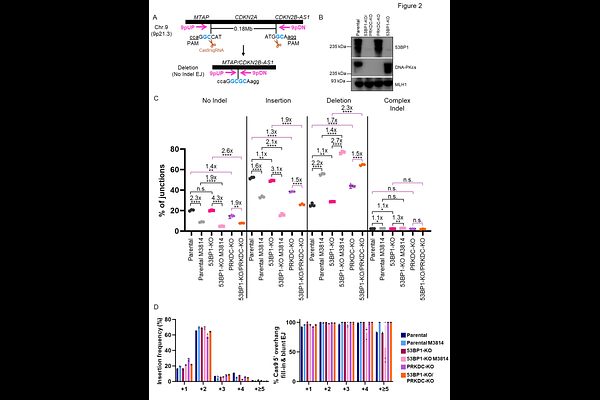53BP1/RIF1 and DNA-PKcs show distinct genetic interactions with diverse chromosomal break repair outcomes.

53BP1/RIF1 and DNA-PKcs show distinct genetic interactions with diverse chromosomal break repair outcomes.
Makins, K.; Cisneros-Aguirre, M.; Lopezcolorado, F. W.; Stark, J. M.
AbstractDNA double strand breaks (DSBs) are the effective lesion of cancer radiotherapy and induce gene editing. 53BP1 accumulates at DSBs and is implicated in end joining (EJ) repair, but its influence on DSB repair is distinct from canonical non-homologous end joining (C-NHEJ). We sought to define the genetic interplay of 53BP1 with C-NHEJ, focusing on the DNA-PKcs kinase. We examined Cas9 DSBs, which largely generates blunt DSBs, since blunt DSB EJ is dependent on C-NHEJ. Loss of 53BP1 does not affect blunt DSB EJ, but causes a reduction in such repair in DNA-PKcs deficient cells. In contrast, disrupting 53BP1 and DNA-PKcs, both alone and together, has similar effects on the type of deletion mutation (increase in microhomology deletions). We found similar effects on EJ with RIF1 loss, which is a downstream effector of 53BP1. Thus, 53BP1/RIF1 appear to play a backup role for DNA-PKcs during blunt DSB EJ, but function in the same pathway to suppress microhomology deletions. In contrast, 53BP1 and DNA-PKcs function independently to suppress homology-directed repair. Finally, DNA-PKcs kinase inhibition causes marked radiosensitivity, which is not additive with loss of 53BP1 and RIF1. Altogether, 53BP1/RIF1 and DNA-PKcs show distinct genetic interactions with diverse DSB repair outcomes.